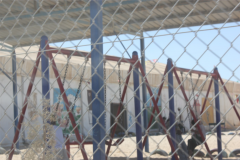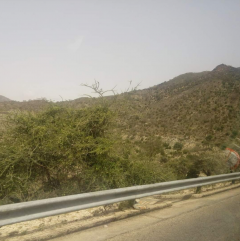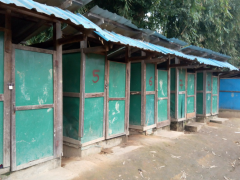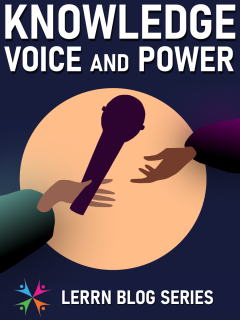Nada Yehia
The Beginning
Growing up in Egypt in the 1990s & 2000s, I have always been surrounded by news about the thousands of displaced people who fled their countries because of occupation, famine, drought, or civil wars. The news told stories about the Palestinian resistance, Palestinian refugee crisis and Palestinian right to return, Somali famine and drought in the horn of Africa, genocide in Rwanda, conflicts in Sudan, war on Iraq, war on Afghanistan, and conflict in Bosnia. I wanted to help, to be there for ‘the victims’ to be saved. In high school, I became a member of the local Red Crescent Society. I then joined the faculty of Mass Communication to be there for “those who need my help” and raise awareness about their plights. The Arab Spring erupted while I was at college and massive numbers of people around the Middle East ended up fleeing their countries. I wanted to be there for them and to take part in providing them with humanitarian assistance, so I pursued a MSc degree on humanitarian action, thinking that this would equip me with the needed skills and knowledge to ‘help’ and ‘provide aid’.
The mainstream narratives in humanitarian, academic, and practical discourses created a sharp dichotomy between those who provide help and those who receive it.
These narratives situate crises in particular spaces and places and attribute victimhood to people of certain races, classes & migration status. I went to my first humanitarian placement in Zaatari Camp in Jordan thinking that there are humanitarians who provide help – who are either expats ‘with extensive experience and knowledge’ or locals who are ‘meant to be trained on humanitarianism’ by the expats – and then refugees who are ‘the victims’ to be saved, provided, assisted, or helped. I was shocked. My whole idea around humanitarianism and humanitarian actors got dismantled when I found out that there are so many refugees who work for international humanitarian organizations inside the camp. So many refugees are part of the suffering because of displacement, yet also part of the response.
Structural Inequalities, Organizational Hierarchies, and Disconnections from Humanitarian Principles
Between 2013 and 2018, as I worked in humanitarian placements across the Middle East, sub-Saharan Africa, and southeast Asia, I have witnessed how refugees and Internally Displaced Persons (IDPs) acted as indispensable humanitarian service providers and a critical part of the workforce of international humanitarian organizations. Yet, their role was always rendered as peripheral volunteers. They take part in meetings, yet they don’t have a say on what will be discussed in the meeting, where the meeting shall take place, or when. They receive financial reimbursement, yet it doesn’t amount to the effort they exert, nor does this compensation equate to the salaries of their peers who haven’t experienced displacement. Their existence is crucial to ‘reach’ the ‘target’ community, yet their systems of knowledge, ways of living, local traditions, and practices of humanitarianism aren’t rendered as valuable or approached as knowledge. The perplexing dynamics of this exclusive inclusion, of welcome and hostility, that existed in the sector among workers occupying different positionalities with varying racial, class and migration statuses urged me to pursue a PhD degree in sociology.
Through the research, I employ a Decolonial approach and Critical Race Theory to examine how refugee agency is cultivated in humanitarian encounters. Twelve oral history narrative interviews were conducted with humanitarian workers occupying different positionalities in the humanitarian sector across the Middle East, sub-Saharan Africa & south/southeast Asia. Mohamed, Manasek, Mawada and Safaa (names changed for privacy) from Sudan and Syria have directly experienced forced migration. Their work in the humanitarian sector varied between educating, coordinating, facilitating, promoting hygiene, offering legal support, and providing psychosocial support, yet they were all contracted as volunteers. Haya, Talal, Sara & Lana are Palestinian Jordanians and have intergenerational legacies of forced migration. Dareen, Amal, and Layal from Egypt and Jordan have not experienced displacement, yet closely worked with humanitarians who have. All humanitarians who have not personally experienced displacement were contracted fixed-term workers. The recruitment of the interlocutors took place through a snowballing sampling technique. Because of COVID and the multiple geographic locations where the interviewees reside, the interviews took place online. In this blog post, I shall focus on how humanitarian practice is disconnected from humanitarian principles and the ways this disconnection manifests in how humanitarians who experienced forced migration access and navigate the humanitarian space as workers.
A Purpose Behind our Presence
“When I used to work as a volunteer, we used to have a volunteer and an employee, the volunteer would work way much more than the employees because most of the volunteers are very well connected to the community. On the other side most of the employees stayed in the office. There wasn’t proper appreciation and there wasn’t any equality. We have different job titles, different contracts, yet we provide the same service. People who used to work as volunteers didn’t have the same value as employees. I felt there was kind of a purpose through our presence and that is it… the organization used to provide certain incentives for people working at it, such incentives were exclusive to the employees which was degrading for volunteers who are working in the field” [Manasek]
Manasek’s reflections on the different labels that exist in international humanitarian organizations was highlighted in the work produced by Reem Farah.1 Her work describes how within the humanitarian sector there are international staff, local or national staff, and volunteers from the refugee community. Through the interviews, it was clear how humanitarian workers’ labels/titles entitle them to have different access to different sets of rights.
Manasek’s experience demonstrated the clear disparities existing in the humanitarian sector between contracted employees and volunteers who are from the forced migrant population.
It is striking the absence of equality in terms of financial remuneration, recognition as equal contracted employees, provision of incentives, and appreciation of the effort exerted. Such practices reflect the extent to which humanitarians from the forced migrant population are treated as a means to an end, regardless of their rights as equal human beings and their valuable contributions to the organization.
These disparities reflect a clear form of disconnection between humanitarian principles and humanitarian practice.
Moreover, interlocutors working across different contexts agreed that there is a certain level of classism and lack of acceptance within the sector among field staff, volunteers, and office staff. Gloria Haddad and Soha Bouchabke2 referred to the exclusive nature of international humanitarian organizations and the fact that there is proliferation of different social groups that compete against each other. In their work, they focused on the disparities that exist between international ‘expats’ and locals. However, the interviews showed that such disparities transcend the international-local dichotomy towards graver disparities that humanitarians from the displaced community encounter.
“I don’t know whether this is an attitude or not … it is always that the organizations advocating for the integration and acceptance of the other … doesn’t really practice what it preaches … there is always a certain level of classism” [Amal]
Through the interviews, it was prevalent that many contracted fixed-term humanitarians refuse to sit with the volunteers in the same spaces. Amal, Haya and Layal mentioned that some refuse to eat with the volunteers, or refuse to organize meetings in the areas where the refugees live and provide the services. In his reflections, Mohamed highlighted that some humanitarians perceive and treat refugees as less equal, as victims to be saved who lack any sort of agency or aptitude.
There is an obvious disconnection between the principles of humanitarian organizations and the practices of some of their employees related to how they approach their colleagues in the field, their colleagues from the forced migrant population, and the general refugee population they are meant to serve.
Anne-Marie Fechter in her work highlighted the fact that individuals’ relationships, belief systems, and values could very much affect the humanitarian practice.3
“Some humanitarians have this tendency to use their positions and disrespect the dignity of people they are supposed to serve.” [Sara]
Other forms of disconnection emerged in the discussions:
“There is a gap between office-based employees and field-based employees …they didn’t always get to properly estimate what we go through in the field … a systematic gap that exists because some don’t really care enough to know … for them everything that is managerial is way much important than whatever happens in the field” [Lana]
Field staff (fixed-term and volunteers) felt that the policies set in the office are disconnected from the main purpose behind the intervention, which demotivates them. Also, management and policy makers are disconnected from the practices that are taking place in the field.
Moving Forward: Promoting Acceptance and Equality, Dismantling Hierarchies
Despite their differences, all the respondents shared similar aspirations towards promoting a culture of acceptance and equality in the humanitarian sector. They stressed the importance of adhering to participatory methods in the development of proposals. They insisted on the importance of monitoring humanitarian workers’ behaviour. They also expressed the need to shift organizational paradigms to focus on quality rather than quantity.
It is crucial to acknowledge the fact that humanitarians who experienced displacement have an indispensable role in providing humanitarian assistance. Their existence as part of the workforce of humanitarian organizations is vital for the provision of humanitarian services. Their roles, voices, experiences of humanitarianism, systems of knowledge and agencies need to be acknowledged and respected. These shifts in culture and in practice are important to dismantle the widespread hierarchies in humanitarian responses.
 Figure 1 Zaatari Camp Jordan 2013 ©Nada
Figure 1 Zaatari Camp Jordan 2013 ©Nada
 Figure 2 Road Somaliland 2017 ©Nada
Figure 2 Road Somaliland 2017 ©Nada
 Figure 3 IDP Camp Myitkyina Myanmar 2018 ©Nada
Figure 3 IDP Camp Myitkyina Myanmar 2018 ©Nada
[1] Reem Farah, 2020 “Expat, Local, and Refugee: ‘Studying Up’ the Global Division of Labor and Mobility in the Humanitarian Industry in Jordan”. Migration and Society.
[2] Gloria Haddad and Soha BouChabke, 2022. “The impact of workplace exclusion on the humanitarian response to the refugee crisis in Lebanon”. Disasters 46 (1): 246−270. Overseas Development Institute.
[3] Anne-Marie Fechter, 2012. “The Personal and the Professional: Aid Workers’ Relationships and Values in the Development Process”. Third World Quarterly 33 (8): 1387–1404.
Nada Yehia
Ph.D. researcher at University College Dublin, sociology teacher and humanitarian practitioner
Email: yehia.nada@gmail.com
LERRN Blog Series: Knowledge, Voice and Power
This blog series continues the conversation from the recently launched Forced Migration Review 70th issue on Knowledge, Voice and Power, which was supported by LERRN. In this blog series we feature authors from around the world reflecting on questions about involving people with lived experiences of displacement in multiple contexts, as well as scholars based in the Global South, from research to policy discussions.
